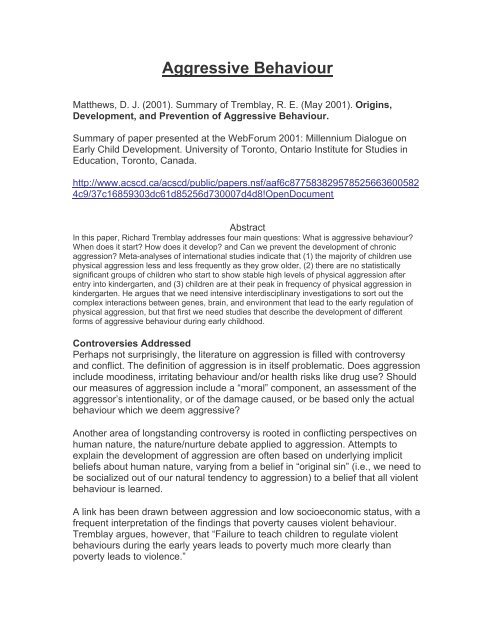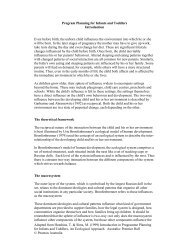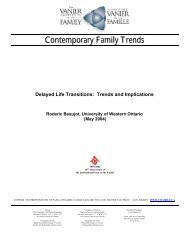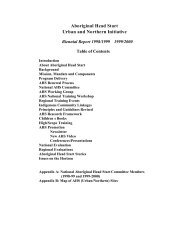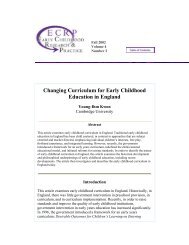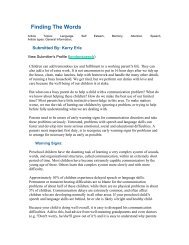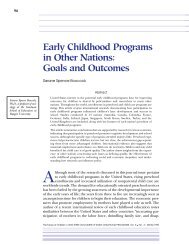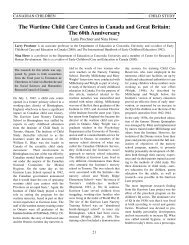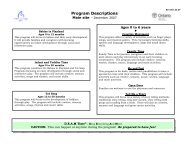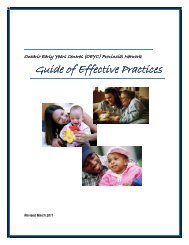Aggressive Behaviour - Peel Early Years
Aggressive Behaviour - Peel Early Years
Aggressive Behaviour - Peel Early Years
Create successful ePaper yourself
Turn your PDF publications into a flip-book with our unique Google optimized e-Paper software.
<strong>Aggressive</strong> <strong>Behaviour</strong><br />
Matthews, D. J. (2001). Summary of Tremblay, R. E. (May 2001). Origins,<br />
Development, and Prevention of <strong>Aggressive</strong> <strong>Behaviour</strong>.<br />
Summary of paper presented at the WebForum 2001: Millennium Dialogue on<br />
<strong>Early</strong> Child Development. University of Toronto, Ontario Institute for Studies in<br />
Education, Toronto, Canada.<br />
http://www.acscd.ca/acscd/public/papers.nsf/aaf6c877583829578525663600582<br />
4c9/37c16859303dc61d85256d730007d4d8!OpenDocument<br />
Abstract<br />
In this paper, Richard Tremblay addresses four main questions: What is aggressive behaviour?<br />
When does it start? How does it develop? and Can we prevent the development of chronic<br />
aggression? Meta-analyses of international studies indicate that (1) the majority of children use<br />
physical aggression less and less frequently as they grow older, (2) there are no statistically<br />
significant groups of children who start to show stable high levels of physical aggression after<br />
entry into kindergarten, and (3) children are at their peak in frequency of physical aggression in<br />
kindergarten. He argues that we need intensive interdisciplinary investigations to sort out the<br />
complex interactions between genes, brain, and environment that lead to the early regulation of<br />
physical aggression, but that first we need studies that describe the development of different<br />
forms of aggressive behaviour during early childhood.<br />
Controversies Addressed<br />
Perhaps not surprisingly, the literature on aggression is filled with controversy<br />
and conflict. The definition of aggression is in itself problematic. Does aggression<br />
include moodiness, irritating behaviour and/or health risks like drug use? Should<br />
our measures of aggression include a “moral” component, an assessment of the<br />
aggressor’s intentionality, or of the damage caused, or be based only the actual<br />
behaviour which we deem aggressive?<br />
Another area of longstanding controversy is rooted in conflicting perspectives on<br />
human nature, the nature/nurture debate applied to aggression. Attempts to<br />
explain the development of aggression are often based on underlying implicit<br />
beliefs about human nature, varying from a belief in “original sin” (i.e., we need to<br />
be socialized out of our natural tendency to aggression) to a belief that all violent<br />
behaviour is learned.<br />
A link has been drawn between aggression and low socioeconomic status, with a<br />
frequent interpretation of the findings that poverty causes violent behaviour.<br />
Tremblay argues, however, that “Failure to teach children to regulate violent<br />
behaviours during the early years leads to poverty much more clearly than<br />
poverty leads to violence.”
What is aggressive behaviour?<br />
Tremblay states that the definition of aggression is historically and currently the<br />
biggest problem in this area of research. As evidence for this argument, he<br />
describes various measurement scales used to assess children’s and<br />
adolescents’ aggressive behaviour, instruments which contain a mix of<br />
behaviours ranging from attention-seeking to physical aggression, with one<br />
widely-used rating system including such items as “argues, brags, disobeys, poor<br />
peer relations, lies, moody, sulks, loud.” He asks if it makes sense to classify<br />
annoying children in the same category as those who attack others.<br />
Another definitional problem is identifying the different forms of expression of<br />
aggression, and differentiating them from other phenomena which are associated<br />
but different, such as hyperactivity and opposition.<br />
Tremblay asks if aggressive behaviour is always antisocial, and if our research<br />
aim in this area is to prevent the development of all aggression. He points out<br />
that the ability to be aggressive when needed is usually considered an asset in<br />
many endeavours, including tennis, sales, and political leadership, which again<br />
raises the question of definition.<br />
A further definitional issue is illustrated by comparing aggression studies with<br />
nonhuman animals with those conducted on humans. Definitions of animal<br />
aggression are almost always based on the animal’s actual behaviour, rather<br />
than on the animal’s intention or on the effect of its behaviour on the “victim.”<br />
Definitions used in human aggression studies, however, are most frequently<br />
“moral” judgements, where an observer decides that the observed behaviour was<br />
or was not intended to be harmful to another. The intent criterion is especially<br />
problematic when studying the development of aggressive behaviour during early<br />
childhood. How can one make a decision about the age that a child might<br />
reasonably be seen as having a conscious intention of injuring another?<br />
The intent criterion is not only a problem for studies of infants and non-human<br />
animals. Current brain research is illustrating how anger and fear can lead to<br />
defensively aggressive reactions in older adults that are clearly not under the<br />
control of individual will.<br />
Although it was noted over 25 years ago that definitional problems were<br />
impeding the progress of research on aggression, these problems have not been<br />
effectively addressed or rectified in the field. Tremblay notes that “Investigators<br />
not only aggregate largely different forms of behaviours which have traditionally<br />
been considered ‘aggressive,’ but they also tend to aggregate aggressive<br />
behaviours with socially disruptive behaviours such as opposition and<br />
hyperactivity, with illegal activities such as smoking marijuana, and with health<br />
related risky behaviours such as not using a condom.”
When do humans start to aggress?<br />
Tremblay reviews many approaches to thinking about this question, which is<br />
often framed as the “age of onset” of aggression. The apparently rapid increase<br />
in deviant behaviour during adolescence, which is followed by an equivalently<br />
rapid decrease and labeled the "age-crime curve,” has been attributed variously<br />
to rising testosterone levels, and to bad environmental influences such as deviant<br />
families, deviant peers, and the media.<br />
There are different beliefs and assumptions that influence our explanations of the<br />
dynamics that underlie aggression. The social learning approach to the<br />
development of aggressive behaviour is that children learn to be aggressive, that<br />
they are taught their behaviour by exposure to adult and peer models and the<br />
media. This emerged as a reaction against a popular mid 20th century idea that<br />
man had inherited an instinct for aggression that he needed to learn to control in<br />
order to prevent self-destruction, which itself has its roots in the much older idea<br />
of original sin.<br />
This debate has important consequences for political scientists, philosophers,<br />
and lawmakers, as well as for child development investigators and educators.<br />
Whether humans are born with a tendency to aggression that needs curbing, or<br />
whether they learn to be aggressive through social learning, makes a difference<br />
in our response to it, including our prevention efforts. Tremblay observes that the<br />
underlying debate is really about our view of human nature.<br />
Results of age of onset studies vary considerably. Studies that depend on<br />
parents’ recall of physical aggression yield findings of later onset than<br />
assessments that are made closer to the time of occurrence. While reports on<br />
the frequency of physical aggression show a decrease from age 4 to 11, indirect<br />
aggression increases from age 4 to 8. Tremblay suggests that the exciting work<br />
that needs to be done is to study intra-individual developmental trajectories of<br />
aggressive behaviours during infancy and toddlerhood, and their relationship with<br />
later development.<br />
A determination of the age onset of physical aggression as happening sometime<br />
during infancy is often not accepted as valid because of its not meeting the<br />
criteria of intentionality and/or harm to the victim. Tremblay points out that<br />
perhaps it is not the infant’s will that is harmless, but the weakness of the infant’s<br />
limbs, and concludes that we cannot identify the origins of aggressive behaviour<br />
by focussing on the consequences of the acts. The focus on the severity of the<br />
consequences of aggressive behaviours is a legitimate area of study, but<br />
different from the study of the origins of aggressive behaviour, and should lead to<br />
different measuring instruments.<br />
How stable is aggressive behaviour?<br />
Although there are studies reporting aggression to be as stable as intelligence,<br />
these findings are highly misleading. Because global assessments of individuals’
elative positions on scales of aggressive behaviour at two points in time are<br />
highly correlated does not mean that assessment of a given form of aggressive<br />
behaviour at time one (e.g., disobedience in class) will accurately predict another<br />
form of aggressive behaviour at another point in time (e.g., arrests for physical<br />
violence). Tremblay points out that this is one of the reasons why the use of<br />
global scales that incorporate aggression, antisocial behaviour, and also<br />
delinquency, have thwarted real understandings of these different phenomena<br />
and their interrelationships.<br />
Meta-analyses of international studies indicate that (1) the majority of children<br />
use physical aggression less and less frequently as they grow older, (2) there are<br />
no statistically significant groups of children who start to show stable high levels<br />
of physical aggression after entry into kindergarten, and (3) children are at their<br />
peak in frequency of physical aggression in kindergarten. These observations<br />
indicate the need to study the preschool years to understand the early<br />
development of physical aggression.<br />
We do not yet have analyses that explain the mechanisms involved in the ups<br />
and downs of physical aggression followed by an increase of verbal and indirect<br />
aggression. Tremblay suggests that there are probably many factors at play,<br />
including neurological maturation, parental behaviour, and interactions with<br />
siblings and peers. The age-brain development curves for higher cognitive<br />
functions and for receptive language and speech production parallel the agephysical<br />
aggression curve. Numerous studies show a link between poor<br />
language performance and antisocial behaviour. Mothers’ coercive behaviour at<br />
five months of age and presence of a sibling are among the best predictors of<br />
high levels of physical aggression between 17 and 42 months of age.<br />
Tremblay argues that we need intensive interdisciplinary investigations to sort out<br />
the complex interactions between genes, brain, and environment that lead to the<br />
early regulation of physical aggression, but that first we need studies that<br />
describe the development of different forms of aggressive behaviour during early<br />
childhood. By understanding different developmental aggression trajectories, we<br />
can plan interventions that help people follow trajectories that lead to the<br />
prosocial use of their proneness to aggressive behaviour. Studies that target<br />
aggressive behaviours need to be longitudinal, with frequently repeated<br />
measurements, optimally occurring at least every 2 to 3 months during the first 3<br />
years, and every 6 months thereafter through to adolescence.<br />
Can we change the course of physical aggression development?<br />
Longitudinal data cannot answer satisfactorily our questions about causation,<br />
and experimentation with children (which might give us answers about causation)<br />
is generally considered unethical. We do however routinely engage in<br />
interventions which are guided by instinct rather than by sound knowledge of<br />
child development, particularly with children and youth who tend to be disruptive.<br />
Tremblay argues that the process by which we establish the effectiveness of
interventions should be experimental, that we should look at intervention efforts<br />
as opportunities to test hypotheses concerning the causes of aggression, while<br />
searching for effective ways to help at risk individuals.<br />
If the regulation of physical aggression is learned during the preschool years, one<br />
would expect that interventions specifically targeting this regulation would<br />
prevent chronic physical aggression, and increase the likelihood of positive<br />
aggression. By targeting different hypothesized causal mechanisms, such as<br />
emotional regulation, executive functions, information processing, impulsivity,<br />
parental discipline, and peer influence, we could test these hypotheses more<br />
directly than with longitudinal studies, and simultaneously find the best preventive<br />
interventions.<br />
Tremblay concludes by observing that children who fail to learn alternatives to<br />
physical aggression during the preschool years are at very high risk of many<br />
problems. They tend to be hyperactive, inattentive, anxious, and fail to help when<br />
others are in need; they are rejected by their classmates, get poor grades, and<br />
disrupt school activities. They tend to be placed in groupings of similar children,<br />
which reinforces their marginal behaviour. They are among the most delinquent<br />
from pre-adolescence onward, most at risk of dropping out of school, having a<br />
serious accident, being violent offenders, and being diagnosed as having a<br />
psychiatric disorder. “Failure to teach children to regulate violent behaviours<br />
during the early years leads to poverty much more clearly than poverty leads to<br />
violence.”<br />
About the Author<br />
Richard Tremblay, Professor of Psychiatry/Psychology and Director of the<br />
Research Unit on Children's Psychosocial Maladjustment at the University of<br />
Montreal, has conducted, for the past sixteen years, a program of<br />
longitudinal/experimental studies on the physical, cognitive, emotional and social<br />
development of children from conception onward, in order to gain a better<br />
understanding of the development and prevention of antisocial and violent<br />
behaviors. He has also tested the short term and long term effects of an<br />
intervention program aimed at preventing adjustment problems in youths. He has<br />
published with his colleagues more than 200 scientific articles, chapters, and<br />
books. He is titular Chair in child development at the University of Montreal, a<br />
member of the National Consortium on Violence Research (USA), Molson Fellow<br />
of the Canadian Institute of Advanced Research, and Fellow of the Royal Society<br />
of Canada.<br />
About This Summary<br />
Dr. Tremblay has provided us with a draft of his paper to be presented at the<br />
WebForum in November, 2001. Following the dialogue among the scientists at<br />
the WebForum, he will write the final version of his review of his field, and his
vision of productive directions for future research, which will be included as a<br />
chapter in the WebForum 2001 volume and curriculum resources. In his draft of<br />
the chapter, he includes relevant references to the work which informs his<br />
opinions and statements, which are included in a separate document.<br />
This summary has been prepared by Dona Matthews, with input from others, as<br />
a source of information for those who wish to participate in the dialogue, and as a<br />
curriculum document for those participating in courses built around<br />
WebForum2001<br />
Matthews, Dona. Tue, 1 May 2001. Articles.<br />
Human Development; gradients; learning society; Agression; Millennium Dialogue.


